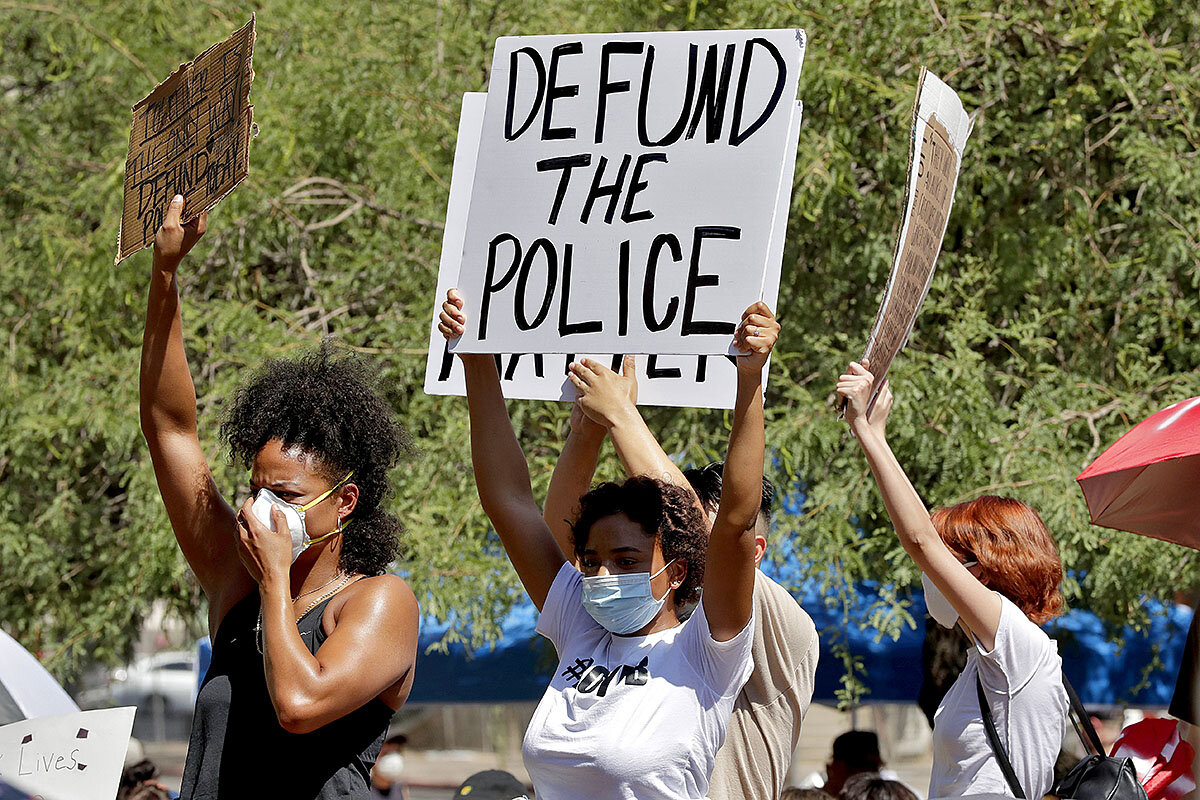In the wake of nationwide protests following the suffocation of George Floyd under the knee of a Minneapolis police officer, the idea of defunding police departments has gained momentum in the national conversation about law enforcement and race. But the term “defund” has led to confusion and pushback from those who worry it means eliminating police entirely.
What does “defund the police” really mean?
Many advocates say the idea is premised on a simple question: What role should police be playing in society, even as their departments are taking up enormous chunks of cash-strapped municipal budgets?
Police officers have become the go-to first responders for a host of social problems that might be better left to other professionals, many argue. Police officers themselves often say they are asked to function as social workers, family counselors, or crisis managers.
“When we talk about defunding the police, it’s different from reform movements in that it suggests you take the huge amounts of funds that you’re sending over to highly armed police forces and invest instead in education and health services and infrastructure, especially within the most marginalized and underrepresented communities,” says Tyler Parry, professor of African American and African diaspora studies at the University of Nevada, Las Vegas.
More controversially, however, other advocates argue that American policing is critically broken, its history is steeped in structural racism and overt racial violence, and that defunding police departments is the first step toward revamping a justice system that is focused on people of color in overwhelming and outsize numbers.
Are the ideas behind defunding the police new?
No. Many scholars make a distinction among three efforts to revamp America’s criminal justice systems over the past few decades: abolish, defund, or reform. In the 1970s, advocates began to call for the abolition of America’s emerging prison industrial complex, the largest in the world by far. Scholars began to study the “systemic racism” within the nation’s criminal justice system, including the so-called war on drugs that has been waged on Black and other nonwhite Americans, even though over 60% of illegal substances such as cocaine and marijuana continue to be consumed by white Americans.
Much of the defund movement today stems from the early ideas of the more radical abolition movement, scholars say. “There’s this growing feeling that reform is just no longer enough,” says Sekou Franklin, professor of political science at Middle Tennessee State University in Murfreesboro. “You’ve had body cameras, for example, you’ve had implicit bias training, you’ve had deescalation training. But you could have all of these reforms, but even still, racial disparities never seem to change.”
Have any U.S. cities begun to defund their police departments?
Minneapolis, the city where George Floyd was killed by police, is poised to redirect police funds to affordable housing, solutions for the opioid epidemic, and other mental health resources. In Los Angeles, city officials said police funding would be cut by $150 million and then redistributed in communities of color “so we can invest in jobs, in health, in education and in healing.” New York City officials announced they would begin to divert funds from the NYPD toward social services. On June 15, city officials also announced that they are disbanding the special unit of 600 plainclothes cops, which has been involved in the city’s most notorious police shootings.
Yet some alternatives predate the Floyd killing. Seven years ago, Camden, New Jersey, abolished its police department and replaced it with a revamped and far less aggressive police force. Last year in Austin, Texas, 911 operators were instructed to ask whether the caller needs police, fire, or mental health services. And in Eugene, Oregon, city officials formed a team called CAHOOTS – Crisis Assistance Helping Out on the Streets – which deploys crisis workers and medics with mental health training to respond to emergency calls.
“Even though the crime rate has declined dramatically over the last 30 years, we still warehouse more than 2.3 million people in prison – and more than half the people in there have substance or alcohol abuse issues, many of them have mental health issues, and almost all of them are poor and have had problems within the educational system or from the lack of jobs in their communities,” says Stephanie Lake, director of the criminal justice program at Adelphi University in New York. “So the big push today is that our society needs to reimagine not just policing, but the role and mission of policing.”






